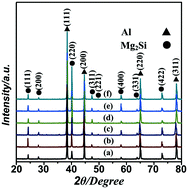Morphology evolution of primary Mg2Si in Al–20Mg2Si–0.1Ca alloys prepared with various solidification cooling rates
Abstract
The morphology evolution of primary Mg2Si in the Al–20Mg2Si–0.1Ca alloy was investigated by a mould temperature-controlled solidification technique at various solidification cooling rates. It is found that by lowering the pre-set mould temperature, i.e. increasing the cooling rates, the influence of external factors, i.e. the adsorption of Ca atoms on {100} facets, on the morphology evolution of primary Mg2Si can be strengthened, leading to primary Mg2Si with varying morphologies. With the decrease of mould temperature from 600 to 400 °C and then to 200 °C and finally to room temperature, primary Mg2Si transformed from a mixture of an equiaxed-dendrite and an octahedron to a truncated octahedron and then to a truncated cube and finally to a cube; in contrast, primary Mg2Si still remained dendritic in the Ca-free Al–20Mg2Si alloy. Moreover, the skeleton-type growth process of the truncated cubic primary Mg2Si in the modified alloy was identified, where growth steps with some hillocks were observed for the first time. Our study offers a simple and low-cost method to control the morphology and size of primary Mg2Si crystals in the Al–Mg–Si alloy, which is beneficial to the design of lightweight Al–Mg–Si alloys with high strength and toughness.



 Please wait while we load your content...
Please wait while we load your content...